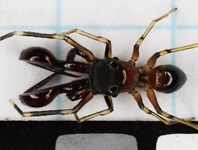Abstract
The genus Myrmarachne MacLeay, 1839 (Araneae: Salticidae) is one of the most diversified salticid groups in Southeast Asia, with 23 species previously recorded from Borneo. Based on the collections accumulated from 2004 to 2014 in the Lambir Hills National Park, we herein describe six new species: M. amabilis sp. nov., M. hashimotoi sp. nov., M. lagarosoma sp. nov., M. leptosoma sp. nov., M. salaputium sp. nov. and M. tintinnabulum sp. nov. In addition, we describe the female of M. endoi Yamasaki & Ahmad, 2013 for the first time. The male-female combination in M. amabilis sp. nov., M. tintinnabulum sp. nov. and M. endoi were confirmed by DNA barcoding.
References
Attygalle, A.B., Siegel, B., Vostrowsky, O., Bestmann, H.J., & Maschwitz, U. (1989) Chemical composition and function of metapleural gland secretion of the ant, Crematogaster deformis Smith (Hymenoptera: Myrmicinae). Journal of chemical ecology, 15, 317–328.
https://doi.org/10.1007/BF02027793Badcock, M.A. (1918) Ant-like spiders from Malaya, collected by the Annandale-Robinson Expedition, 1901–2. Proceedings of the Zoological Society of London, 1917, 277–321.
https://doi.org/10.1111/j.1096-3642.1917.tb02070.xBanks, N. (1930) Ant-like spiders of the genus Myrmarachne from the Philippines. Psyche, 37, 207–218.
https://doi.org/10.1155/1930/97165Benjamin, S.P. (2015) Model mimics: antlike jumping spiders of the genus Myrmarachne from Sri Lanka. Journal of Natural History, 49, 2609–2666.
https://doi.org/10.1080/00222933.2015.1034209Edgar, R.C. (2004) MUSCLE: multiple sequence alignment with high accuracy and high throughput. Nucleic Acids Research, 32, 1792–1797.
https://doi.org/10.1093/nar/gkh340Edmunds, M. (2000) Why are there good and poor mimics? Biological Journal of the Linnean Society, 70, 459–466.
https://doi.org/10.1111/j.1095-8312.2000.tb01234.xEdmunds, M. (2006) Do Malaysian Myrmarachne associate with particular species of ants? Biological Journal of the Linnean Society, 88, 645–653.
https://doi.org/10.1111/j.1095-8312.2006.00649.xEdmunds, M. & Prószyński, J. (2003) On a collection of Myrmarachne species (Araneae: Salticidae) from peninsular Malaya. Bulletin of the British Arachnological Society, 12, 297–323.
Hedin, M.C. & Maddison, W.P. (2001) A combined molecular approach to phylogeny of the jumping spider subfamily Dendryphantinae (Araneae: Salticidae). Molecular Phylogenetics and Evolution, 18, 386–403.
https://doi.org/10.1006/mpev.2000.0883Hölldobler, B. & Wilson, E.O. (1990) The Ants. Belknap Press of Harvard University Press, Cambridge, MA, 732 pp.
Huang, J.N., Cheng, R.C., Li, D. & Tso, I.M. (2011) Salticid predation as one potential driving force of ant mimicry in jumping spiders. Proceedings of the Royal Society B, 278, 1356–1364.
https://doi.org/10.1098/rspb.2010.1896Hyodo, F., Yamasaki, T., Iwasa, T. Itioka, T., Endo, T. & Hashimoto, Y. (in press) Stable isotope analysis reveals the importance of plant-based diets for tropical ant-mimicking spiders. Entomological Science.
Ito, F., Hashim, R., Huei, Y.S., Kaufmann, E., Akino, T. & Billen, J. (2004) Spectacular Batesian mimicry in ants. Naturwissenschaften, 91, 481–484.
https://doi.org/10.1007/s00114-004-0559-zJones, T.H., Brunner, S.R., Edwards, A.A., Davidson, D.W. & Snelling, R.R. (2005) 6-Alkylsalicylic acids and 6-alkylresorcylic acids from ants in the genus Crematogaster from Brunei. Journal of chemical ecology, 31, 407–417.
https://doi.org/10.1007/s10886-005-1349-6Karsch, F. (1880) Arachnologische Blätter (Decas I). Zeitschrift für die gesammten Naturwissenschaften, 53, 373–409.
Kimura, M. (1980) A simple method for estimating evolutionary rate of base substitutions through comparative studies of nucleotide sequences. Journal of Molecular Evolution, 16, 111–120.
https://doi.org/10.1007/BF01731581Koch, C.L. (1846) Die Arachniden. Dreizehnter Band. In der C. H. Zeh'schen Buchhandlung, Nürnberg, 234 pp.
MacLeay, W.S. (1839) On some new forms of Arachnida. Annals of Natural History, 2, 1–14.
https://doi.org/10.1080/00222933809496646Maddison, W.P. & Hedin, M.C. (2003) Jumping spider phylogeny (Araneae: Salticidae). Invertebrate Systematics, 17, 529–549.
https://doi.org/10.1071/IS02044Maschwitz, U. (1974) Vergleichende Untersuchungen zur Funktion der Ameisenmetathorakaldrüse. Oecologia, 16, 303–310.
https://doi.org/10.1007/BF00344739Nelson, X.J. & Jackson, R.R. (2006) Vision-based innate aversion to ants and ant mimics. Behavioral Ecology, 17, 676–681.
https://doi.org/10.1093/beheco/ark017Peckham, G.W. & Peckham, E.G. (1892) Ant-like spiders of the family Attidae. Occasional Papers of the Natural History Society of Wisconsin, 2, 1–83.
Peckham, G.W. & Peckham, E.G. (1907) The Attidae of Borneo. Transactions Wisconsin Academy of Sciences, Arts and Letters, 15, 603–653.
Pfeiffer, M., Mezger, D., Hosoishi, S., Bakhtiar, Y.E. & Kohout, R.J. (2011) The Formicidae of Borneo (Insecta: Hymenoptera): a preliminary species list. Asian Myrmecology, 4, 9–58.
https://doi.org/10.20362/am.004002Prószyński, J. (2001) Remarks on jumping spiders of the genus Damoetas related to Myrmarachne (Araneae: Salticidae) with description of two new species. Annales Zoologici, 51, 517–522.
Prószyński, J. (2016) Delimitation and description of 19 new genera, a subgenus and a species of Salticidae (Araneae) of the world. Ecologica Montenegrina, 7, 4–32.
Prószyński, J. & Deeleman-Reinhold, C.L. (2010) Description of some Salticidae (Araneae) from the Malay Archipelago. I. Salticidae of the Lesser Sunda Islands, with comments on related species. Arthopoda Selecta, 19, 153–188.
Phung, T.H.L., Yamasaki, T. & Eguchi, K. (2016) Conspecificity of Phintella aequipeiformis Żabka, 1985 and P. lucai Żabka, 1985 (Araneae: Salticidae) confirmed by DNA barcoding. Revue Suisse de Zoologie, 123, 283–290.
https://doi.org/10.5281/zenodo.155301Robinson E.A., Blagoev, G.A., Hebert, P.D.N. & Adamowicz, S.J. (2009) Prospects for using DNA barcoding to identify spiders in species-rich genera. ZooKeys, 16, 27–46.
https://doi.org/10.3897/zookeys.16.239Simon, E. (1900) Descriptions d'arachnides nouveaux de la famille des Attidae. Annales de la Société Entomologique de Belgique, 44, 381–407.
Simon, C., Frati, F., Beckenbach, A., Crespi, B., Liu, H. & Flook, P. (1994) Evolution, weighting, and phylogenetic utility of mitochondrial gene sequences and a compilation of conserved polymerase chain reaction primers. Annals of the entomological Society of America, 87, 651–701.
https://doi.org/10.1093/aesa/87.6.651Tamura, K., Stecher, G., Peterson, D., Filipski, A. & Kumar, S. (2013) MEGA6: Molecular evolutionary genetics analysis version 6.0. Molecular Biology and Evolution, 30, 2725–2729.
https://doi.org/10.1093/molbev/mst197Thorell, T. (1877) Studi sui Ragni Malesi e Papuani. I. Ragni di Selebes raccolti nel 1874 dal Dott. O. Beccari. Annali del Museo Civico di Storia Naturale di Genova, 10, 341–634.
Yamasaki, T. (2010) Redescriptions of two Bornean species of the genus Myrmarachne (Araneae: Salticidae). Acta Arachnologica, 59, 63–66.
https://doi.org/10.2476/asjaa.59.63Yamasaki, T. (2015) Studies on taxonomy, biogeography and mimicry of the genus Myrmarachne in Southeast Asia. Acta Arachnologica, 64, 49–56. [in Japanese]
http://doi.org/10.2476/asjaa.64.49Yamasaki, T. & Ahmad, A.H. (2013) Taxonomic study of the genus Myrmarachne of Borneo (Araneae: Salticidae). Zootaxa, 3710 (6), 501–556.
https://doi.org/10.11646/zootaxa.3710.6.1Yek, S.H. & Mueller, U.G. (2011) The metapleural gland of ants. Biological Reviews, 86, 774–791.
https://doi.org/10.1111/j.1469-185X.2010.00170.xWorld Spider Catalog (2018) World Spider Catalog. Natural History Museum Bern. Version 19.5. Available from: http://wsc.nmbe.ch (accessed 4 August 2018)
https://doi.org/10.24436/2Żabka, M. (1985) Systematic and zoogeographic study on the family Salticidae (Araneae); from Viet-nam. Annales Zoologici, 39, 197–485.

